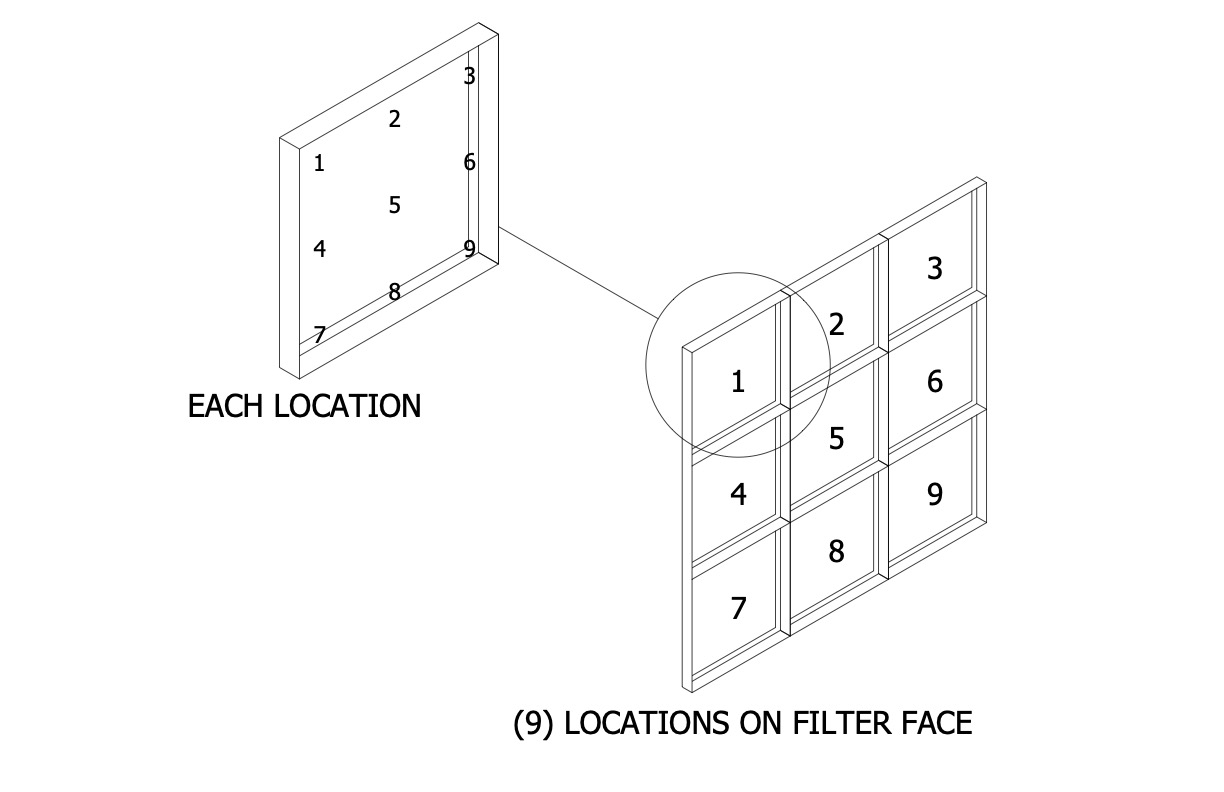There are many of different ways to measure air flow in your spray booth, but at RTT Engineered Solutions, we have one that we believe is the best.
Before we get into our tutorial, let’s start with some of the tools you can use to measure air flow. Air flow is how much air velocity is moving through the filter face and should be measured in feet per minute. There are many different devices that can measure this for you.
1. Anemometer: Air moves through a turning vein that spins and the device calculates your reading.
2. Digital Manometer: This device measures pressure differential. It will give you a pressure reading and with some mathematical equations along with the duct size you can determine how much air is moving through the duct in cubic feet per minute.
3. Hot Wire: Very accurate but also very expensive. Air passes through a probe on the end. Calculates area and figures all the math for you.
4. Averaging air velocity probe: 16 measurements at 1 time. The downfall is that the range is 1000-5000 ft per minute, which is probably too high since we are looking at the 100-300 ft per minute range. It also needs to be hooked to a manometer and requires a good bit of math after that.
5. Velometer: This is the simplest device and the one we recommend. Keep reading to learn how to use this device and calculate the air flow in your spray booth.
As a booth begins to run and operate, most operators can tell when a booth is starting to suffer, like when the overspray is hanging a little longer than it used to. This is the time that having the air flow readings is crucial because we will know that the filters need to be changed before that point. If you are not moving the designed feet per minute, not only are you wasting productivity but, you are violating national standards and you might be creating hazardous environments for your painters.
Measuring air flow is a good base line to know what your booth is moving with clean filters and, it’s very important info when you are setting up a manometer. What we will explain below is the best and most accurate way to do it. It does take a little more time, but this is how RTT recommends that you do it.
The Step-by Step Guide to Measure Airflow in your Spray Booth:
For this example, we are going to be using a 20-foot wide crossdraft booth and we are going to be using a velometer to measure air flow.
If you stood in the center of the booth and you held the velometer out you might not get a lot of velocity, but if you moved over to the wall, you could get well over 100 feet per minute. Air will profile around things and so in a crossdraft situation, exhaust panels will generally be on the back corner of each wall, dragging the air that way. If we were to put a product to spray in the booth, 15-16 feet wide, the air flow would profile around that part. If we take the velometer close to the part, we will get a lot more consistent air flow reading due to the air profiling the part.
One location we can be certain airflow is present is the exhaust filter face, so that is where we want to take these readings. Ideally, we would take 9 readings of the filter in 9 different places. But if it’s a smaller area, such as a smaller booth, you can reduce that number. The important thing is that you take as many measurements as you can so that you have as many data points as possible to find your average.

When measuring, you want to hold the measurement device 2-3 inches from the filter face and record. If the fan is mounted on top with a clean filter, you will likely have more air flow closer to the fan than you will lower. As the booth functions and the overspray gets into the filters, resistance will go to the top and air will move down the plenum. Meaning, you will get higher readings at the top and lower at the bottom.
There are a lot of variables that come into play with the readings that we get. For example, if there are multiple fans in an exhaust plenum, you will see higher readings where the fan is located. So, when you are taking measurements, getting readings from all areas will give you the best average reading.
The Math:
Again, we would like to have 9 readings in 9 different locations to get the broadest span of inputs across the filter face. The more we have the more accurate the calculation will be.
First, we want to get a sum of all the figures to get an average. You need to add together all the data points you have taken to get the sum of all of them. The sum will be equal to X. If we have 24 data points to get that sum, you will then divide the sum by 24 to find the average foot per minute.
For example, if our filter area is a 20”x80” and the booth fan is designed at 2200 CFM. Which was the designed airflow requirements for the booth.
With this information, we now need to find the square inches because ultimately, we need that number to find the square footage to find cubic feet per minute.
We have 20” wide multiplied by the 80” tall filter area, which equals 1600 square inches. Now we need to convert that number to square feet because we are trying to find cubic feet per minute.
So, we will take the 1600 square inches divided by 144 (which is a 12×12 area) and that will equal approximately 11 square ft of filter area.
Next, we need to bring in our average feet per minute, which is the number we calculated above with our 24 data points. For this example, let’s use 232 feet per minute.
For the final step, to get our Calculated CFM, we will take the 232 ft/min (average of our data points) multiplied by 11 square feet (our filter area) for a final calculation of 2552 cfm.
If the booth was designed at 2200 cfm, we are moving very close to where we need to be. Because this is just a calculated cfm, we can assume that the booth is operating at its full potential because there will be some, variance within the calculated numbers.
For more details on calculating air flow in your spray booth, watch the full video here.
